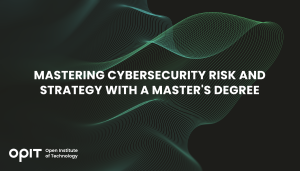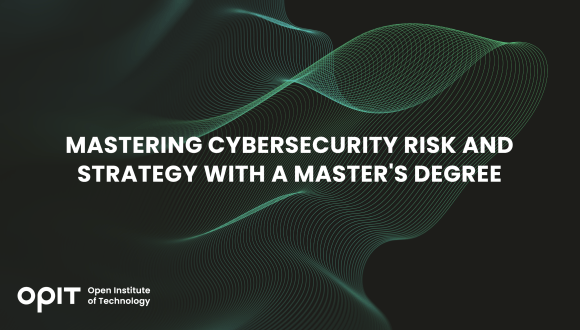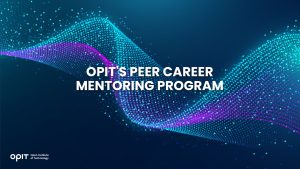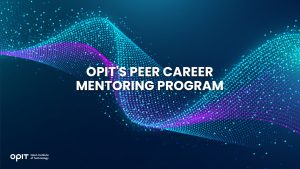

The world has become interconnected by technology and information. The vast amount of data available to companies has also made it increasingly evident that it needs to be stored and protected. It’s no surprise that there are around 2,300 cyberattacks daily, and that number is only expected to rise, seeing that 2023 saw over 70% more attacks than 2021.
These statistics open the door for valuable employment opportunities for specialists in cybersecurity and risk strategy. A cybersecurity expert in Germany can earn between €58k and €85k per year, and the wages in the U.S. are even higher.
Cybersecurity is a relatively vast field that requires both broad IT and management knowledge, but also dedicated experience that correlates to particular job postings. That makes cybersecurity experts difficult to find, as evidenced by the fact that Indeed currently has around 13,000 positions related to the industry.
If you’re already working in IT or planning an IT career, obtaining a master of science in cybersecurity and risk strategy can help you secure a lucrative position.
Understanding Cybersecurity Risk and Strategy
Cybersecurity risk and strategy analyzes the potential for attacks and creates proactive and reactive defenses against them. A complete risk and strategy outline must include all the potential consequences of an attack, such as financial, reputation, and operational losses. In general, a cybersecurity risk and strategy expert will do the following:
- Identify vulnerabilities in the system, whether they come from technical aspects (improper password storage) or human factors (susceptibility to phishing).
- Outline risk factors and the possible rates of attack.
- Create proactive measures, such as implementing more robust security protocols or training personnel on safe online practices.
- Detect attacks once they do come through via intrusion detection systems or other benchmarks.
- Coordinate efforts to contain and remove threats and recover lost data or funds.
A cybersecurity specialist needs to have expert knowledge in various technologies but also solid interpersonal and psychological skills. That’s why a dedicated master’s degree in cybersecurity can help create a complete skillset for the role.
The Curriculum of a Master’s in Cybersecurity Risk and Strategy
A master’s degree in cybersecurity builds upon the IT essentials from a dedicated bachelor’s program. As such, it will likely cover the following:
- Cryptography
- Secure coding practices
- Operating system security
- Network security
- Penetration testing
- Vulnerability assessment
- Government and national cybersecurity
- Ethics, governance, and law implications of cybersecurity
- Systems and security management
- Incident response tactics
However, even more importantly, a good master’s degree program must provide real-life practice assessments. It will allow students to apply the theoretical knowledge and gain valuable experience throughout the curriculum.
Thankfully, online learning has made this type of approach more accessible. Since cybersecurity is web-related by nature, online courses can give students the full breadth of experience and provide more opportunities for a holistic understanding of the subjects and how cybersecurity advances globally.
Take the OPIT Master’s Degree in Enterprise Cybersecurity as a perfect example of this concept. It’s an online-first master’s program that delves deep into cybersecurity concepts such as network security and intrusion detection, cryptography, and even AI in cybersecurity and systems management. Furthermore, students can sign up for practical internships with some of the industry leaders in data management and cybersecurity systems.
Career Outcomes With a Master’s in Cybersecurity
Since IT is a versatile industry, cybersecurity is no different. Students who obtain a master’s degree in this field can have a slew of openings available to them. Entry-to-mid-level roles include:
- Security engineer: In charge of designing, implementing, and maintaining security protocols.
- Penetration tester: Designs programs that ethically hack into existing systems to uncover exploits and vulnerabilities so they can be patched before malicious hackers can reveal them.
- Security analyst: Analyzes information provided by security systems to uncover possible threats and assist other cybersecurity roles.
Mid-to-senior level roles include:
- Security system architect: Designs and implements secure IT infrastructures. Architects can specialize in one specific sub-field, such as cloud, network, or local systems engineering.
- Security manager: In charge of an entire organization’s security systems and implementation.
- Threat response manager: Directly responsible for minimizing the consequences of an active threat or incident.
- Cybersecurity compliance officer: Ensures that the company follows the most recent ethical and legal standards in implementing proactive measures.
- Chief information security officer (CSO or CISO): A leadership position for broad cybersecurity management in larger corporations.
The Online Advantage: Pursuing Your Master’s at OPIT
If you’re interested in a career in cybersecurity, you might have been discouraged to find expensive or prohibitive local colleges. While in-person lessons have their merits, not all colleges are created equal and provide modern knowledge and practice to sharpen students’ skills and prepare them for work.
That’s why OPIT has designed an all-online master’s degree in enterprise cybersecurity. It’s a fully accredited three-term course providing broad and relevant knowledge in modern cybersecurity mechanics.
However, what sets OPIT apart from traditional online degrees is its close relationship with industry leaders. This is emphasized by the complete support from the institution staff and a close-knit community from its digital campus. The courses are a mixture of pre-recorded content that students gain full access to as well as live classes with guests from companies that can share their experience with cybersecurity measures.
As such, OPIT focuses on teaching students relevant skills and how to apply them in real-world situations. Additionally, the course doesn’t have a final exam but provides periodic assessments through projects and assignments to ensure what you learn sticks.
The master’s degree can last between 12 and 18 months, depending on whether you want to take the classes at an accelerated rate. The admission cost is €6,750, with discounts if you apply and pay the entire fee early. The application process is fully online. You need a background in STEM or a bachelor’s degree in a relevant field and be proficient in English.
Becoming a Leader in Cybersecurity
Ultimately, the aim of a master’s degree is to provide students with relevant skills and experience to advance in their careers (or make a significant change).
Apart from teaching technical subjects, the degree focuses on creating situations where students have to apply critical thinking. As mentioned, modern cybersecurity has a significant human factor, so students will also need to develop their interpersonal and management skills if they want to advance to senior-level roles.
OPIT’s master program allows students to partake in interactive projects that will test their newfound knowledge and allow them to flourish in controlled environments with full support from the faculty. This will help reinforce their knowledge and allow them to be more adaptable in the future.
Learn From the Best With OPIT
Since cybersecurity is a rapidly-advancing industry with extreme potential for growth, prospective IT specialists need to be proactive with their learning. Online courses such as OPIT’s master’s degree in enterprise cybersecurity provide all the relevant skills and experience to create a foothold for a successful career in the industry.
Take the next step in your career and upskill yourself with OPIT. Click here to learn more and apply.
Related posts

Source:
- Raconteur, published on November 06th, 2025
Many firms have conducted successful Artificial Intelligence (AI) pilot projects, but scaling them across departments and workflows remains a challenge. Inference costs, data silos, talent gaps and poor alignment with business strategy are just some of the issues that leave organisations trapped in pilot purgatory. This inability to scale successful experiments means AI’s potential for improving enterprise efficiency, decision-making and innovation isn’t fully realised. So what’s the solution?
Although it’s not a magic bullet, an AI operating model is really the foundation for scaling pilot projects up to enterprise-wide deployments. Essentially it’s a structured framework that defines how the organisation develops, deploys and governs AI. By bringing together infrastructure, data, people, and governance in a flexible and secure way, it ensures that AI delivers value at scale while remaining ethical and compliant.
“A successful AI proof-of-concept is like building a single race car that can go fast,” says Professor Yu Xiong, chair of business analytics at the UK-based Surrey Business School. “An efficient AI technology operations model, however, is the entire system – the processes, tools, and team structures – for continuously manufacturing, maintaining, and safely operating an entire fleet of cars.”
But while the importance of this framework is clear, how should enterprises establish and embed it?
“It begins with a clear strategy that defines objectives, desired outcomes, and measurable success criteria, such as model performance, bias detection, and regulatory compliance metrics,” says Professor Azadeh Haratiannezhadi, co-founder of generative AI company Taktify and professor of generative AI in cybersecurity at OPIT – the Open Institute of Technology.
Platforms, tools and MLOps pipelines that enable models to be deployed, monitored and scaled in a safe and efficient way are also essential in practical terms.
“Tools and infrastructure must also be selected with transparency, cost, and governance in mind,” says Efrain Ruh, continental chief technology officer for Europe at Digitate. “Crucially, organisations need to continuously monitor the evolving AI landscape and adapt their models to new capabilities and market offerings.”
An open approach
The most effective AI operating models are also founded on openness, interoperability and modularity. Open source platforms and tools provide greater control over data, deployment environments and costs, for example. These characteristics can help enterprises to avoid vendor lock-in, successfully align AI to business culture and values, and embed it safely into cross-department workflows.
“Modularity and platformisation…avoids building isolated ‘silos’ for each project,” explains professor Xiong. “Instead, it provides a shared, reusable ‘AI platform’ that integrates toolchains for data preparation, model training, deployment, monitoring, and retraining. This drastically improves efficiency and reduces the cost of redundant work.”
A strong data strategy is equally vital for ensuring high-quality performance and reducing bias. Ideally, the AI operating model should be cloud and LLM agnostic too.
“This allows organisations to coordinate and orchestrate AI agents from various sources, whether that’s internal or 3rd party,” says Babak Hodjat, global chief technology officer of AI at Cognizant. “The interoperability also means businesses can adopt an agile iterative process for AI projects that is guided by measuring efficiency, productivity, and quality gains, while guaranteeing trust and safety are built into all elements of design and implementation.”
A robust AI operating model should feature clear objectives for compliance, security and data privacy, as well as accountability structures. Richard Corbridge, chief information officer of Segro, advises organisations to: “Start small with well-scoped pilots that solve real pain points, then bake in repeatable patterns, data contracts, test harnesses, explainability checks and rollback plans, so learning can be scaled without multiplying risk. If you don’t codify how models are approved, deployed, monitored and retired, you won’t get past pilot purgatory.”
Of course, technology alone can’t drive successful AI adoption at scale: the right skills and culture are also essential for embedding AI across the enterprise.
“Multidisciplinary teams that combine technical expertise in AI, security, and governance with deep business knowledge create a foundation for sustainable adoption,” says Professor Haratiannezhadi. “Ongoing training ensures staff acquire advanced AI skills while understanding associated risks and responsibilities.”
Ultimately, an AI operating model is the playbook that enables an enterprise to use AI responsibly and effectively at scale. By drawing together governance, technological infrastructure, cultural change and open collaboration, it supports the shift from isolated experiments to the kind of sustainable AI capability that can drive competitive advantage.
In other words, it’s the foundation for turning ambition into reality, and finally escaping pilot purgatory for good.

The Open Institute of Technology (OPIT) is the perfect place for those looking to master the core skills and gain the fundamental knowledge they need to enter the exciting and dynamic environment of the tech industry. While OPIT’s various degrees and courses unlock the doors to numerous careers, students may not know exactly which line of work they wish to enter, or how, exactly, to take the next steps.
That’s why, as well as providing exceptional online education in fields like Responsible AI, Computer Science, and Digital Business, OPIT also offers an array of career-related services, like the Peer Career Mentoring Program. Designed to provide the expert advice and support students need, this program helps students and alumni gain inspiration and insight to map out their future careers.
Introducing the OPIT Peer Career Mentoring Program
As the name implies, OPIT’s Peer Career Mentoring Program is about connecting students and alumni with experienced peers to provide insights, guidance, and mentorship and support their next steps on both a personal and professional level.
It provides a highly supportive and empowering space in which current and former learners can receive career-related advice and guidance, harnessing the rich and varied experiences of the OPIT community to accelerate growth and development.
Meet the Mentors
Plenty of experienced, expert mentors have already signed up to play their part in the Peer Career Mentoring Program at OPIT. They include managers, analysts, researchers, and more, all ready and eager to share the benefits of their experience and their unique perspectives on the tech industry, careers in tech, and the educational experience at OPIT.
Examples include:
- Marco Lorenzi: Having graduated from the MSc in Applied Data Science and AI program at OPIT, Marco has since progressed to a role as a Prompt Engineer at RWS Group and is passionate about supporting younger learners as they take their first steps into the workforce or seek career evolution.
- Antonio Amendolagine: Antonio graduated from the OPIT MSc in Applied Data Science and AI and currently works as a Product Marketing and CRM Manager with MER MEC SpA, focusing on international B2B businesses. Like other mentors in the program, he enjoys helping students feel more confident about achieving their future aims.
- Asya Mantovani: Asya took the MSc in Responsible AI program at OPIT before taking the next steps in her career as a Software Engineer with Accenture, one of the largest IT companies in the world, and a trusted partner of the institute. With a firm belief in knowledge-sharing and mutual support, she’s eager to help students progress and succeed.
The Value of the Peer Mentoring Program
The OPIT Peer Career Mentoring Program is an invaluable source of support, inspiration, motivation, and guidance for the many students and graduates of OPIT who feel the need for a helping hand or guiding light to help them find the way or make the right decisions moving forward. It’s a program built around the sharing of wisdom, skills, and insights, designed to empower all who take part.
Every student is different. Some have very clear, fixed, and firm objectives in mind for their futures. Others may have a slightly more vague outline of where they want to go and what they want to do. Others live more in the moment, focusing purely on the here and now, but not thinking too far ahead. All of these different types of people may need guidance and support from time to time, and peer mentoring provides that.
This program is also just one of many ways in which OPIT bridges the gaps between learners around the world, creating a whole community of students and educators, linked together by their shared passions for technology and development. So, even though you may study remotely at OPIT, you never need to feel alone or isolated from your peers.
Additional Career Services Offered by OPIT
The Peer Career Mentoring Program is just one part of the larger array of career services that students enjoy at the Open Institute of Technology.
- Career Coaching and Support: Students can schedule one-to-one sessions with the institute’s experts to receive insightful feedback, flexibly customized to their exact needs and situation. They can request resume audits, hone their interview skills, and develop action plans for the future, all with the help of experienced, expert coaches.
- Resource Hub: Maybe you need help differentiating between various career paths, or seeing where your degree might take you. Or you need a bit of assistance in handling the challenges of the job-hunting process. Either way, the OPIT Resource Hub contains the in-depth guides you need to get ahead and gain practical skills to confidently move forward.
- Career Events: Regularly, OPIT hosts online career event sessions with industry experts and leaders as guest speakers about the topics that most interest today’s tech students and graduates. You can join workshops to sharpen your skills and become a better prospect in the job market, or just listen to the lessons and insights of the pros.
- Internship Opportunities: There are few better ways to begin your professional journey than an internship at a top-tier company. OPIT unlocks the doors to numerous internship roles with trusted institute partners, as well as additional professional and project opportunities where you can get hands-on work experience at a high level.
In addition to the above, OPIT also teams up with an array of leading organizations around the world, including some of the biggest names, including AWS, Accenture, and Hype. Through this network of trust, OPIT facilitates students’ steps into the world of work.
Start Your Study Journey Today
As well as the Peer Career Mentoring Program, OPIT provides numerous other exciting advantages for those who enroll, including progressive assessments, round-the-clock support, affordable rates, and a team of international professors from top universities with real-world experience in technology. In short, it’s the perfect place to push forward and get the knowledge you need to succeed.
So, if you’re eager to become a tech leader of tomorrow, learn more about OPIT today.
Have questions?
Visit our FAQ page or get in touch with us!
Write us at +39 335 576 0263
Get in touch at hello@opit.com
Talk to one of our Study Advisors
We are international
We can speak in:


